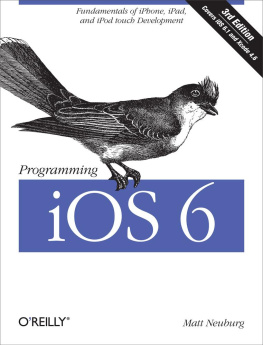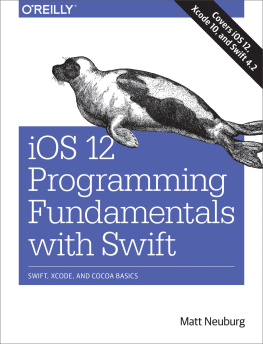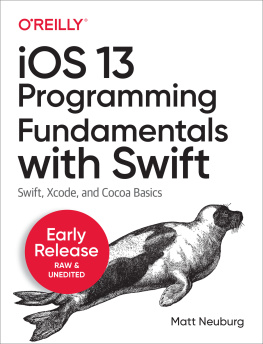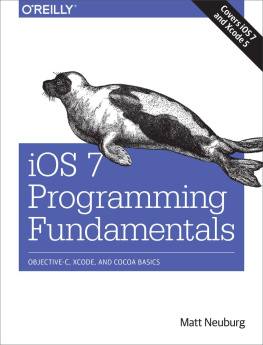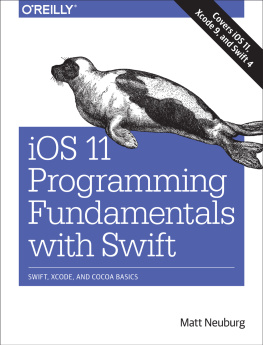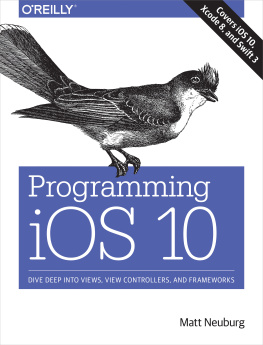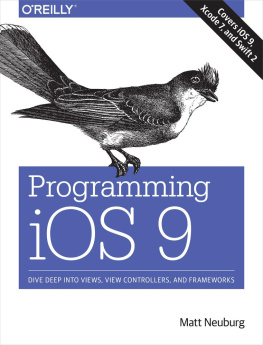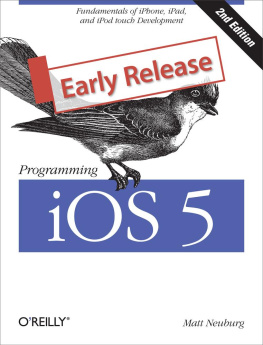Matt Neuburg - Programming iOS 14
Here you can read online Matt Neuburg - Programming iOS 14 full text of the book (entire story) in english for free. Download pdf and epub, get meaning, cover and reviews about this ebook. year: 2021, publisher: OReilly Media, Inc., genre: Computer. Description of the work, (preface) as well as reviews are available. Best literature library LitArk.com created for fans of good reading and offers a wide selection of genres:
Romance novel
Science fiction
Adventure
Detective
Science
History
Home and family
Prose
Art
Politics
Computer
Non-fiction
Religion
Business
Children
Humor
Choose a favorite category and find really read worthwhile books. Enjoy immersion in the world of imagination, feel the emotions of the characters or learn something new for yourself, make an fascinating discovery.
- Book:Programming iOS 14
- Author:
- Publisher:OReilly Media, Inc.
- Genre:
- Year:2021
- Rating:3 / 5
- Favourites:Add to favourites
- Your mark:
- 60
- 1
- 2
- 3
- 4
- 5
Programming iOS 14: summary, description and annotation
We offer to read an annotation, description, summary or preface (depends on what the author of the book "Programming iOS 14" wrote himself). If you haven't found the necessary information about the book — write in the comments, we will try to find it.
Programming iOS 14 — read online for free the complete book (whole text) full work
Below is the text of the book, divided by pages. System saving the place of the last page read, allows you to conveniently read the book "Programming iOS 14" online for free, without having to search again every time where you left off. Put a bookmark, and you can go to the page where you finished reading at any time.
Font size:
Interval:
Bookmark:
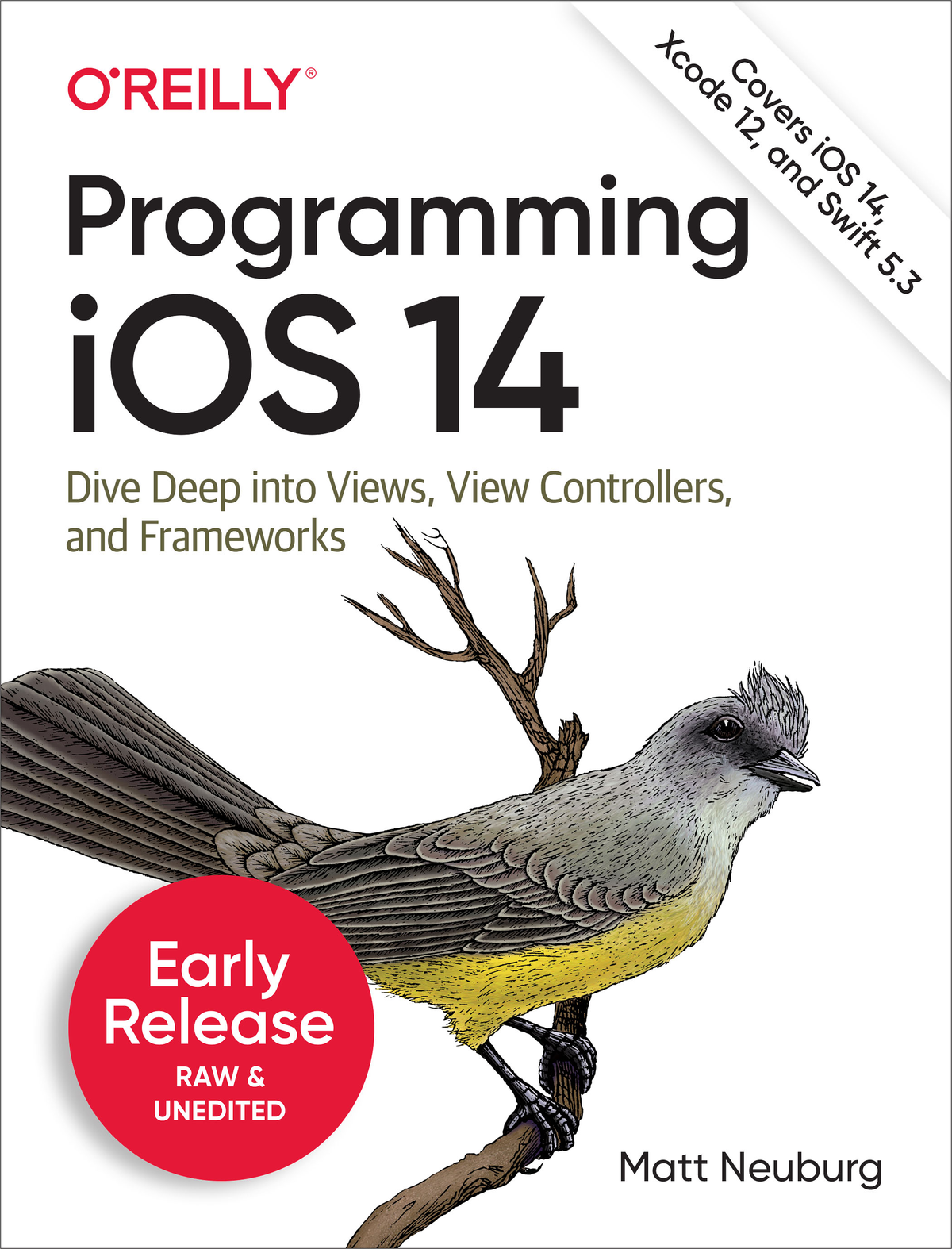
by Matt Neuburg
Copyright 2021 Matt Neuburg. All rights reserved.
Printed in Canada.
Published by OReilly Media, Inc. , 1005 Gravenstein Highway North, Sebastopol, CA 95472.
OReilly books may be purchased for educational, business, or sales promotional use. Online editions are also available for most titles (http://oreilly.com). For more information, contact our corporate/institutional sales department: 800-998-9938 or corporate@oreilly.com .
- Editor: Rachel Roumeliotis
- Production Editor: Kristen Brown
- Proofreader: OReilly Production Services
- Indexer: Matt Neuburg
- Cover Designer: Randy Comer
- Interior Designer: David Futato
- Illustrator: Matt Neuburg
- May 2011: First Edition
- March 2012: Second Edition
- March 2013: Third Edition
- December 2013: Fourth Edition
- December 2014: Fifth Edition
- November 2015: Sixth Edition
- November 2016: Seventh Edition
- December 2017: Eighth Edition
- October 2018: Ninth Edition
- October 2019: Tenth Edition
- October 2020: Eleventh Edition
- 2020-08-11: First early release
See http://oreilly.com/catalog/errata.csp?isbn=9781492092179 for release details.
The OReilly logo is a registered trademark of OReilly Media, Inc. Programming iOS 14, the cover image of a kingbird, and related trade dress are trademarks of OReilly Media, Inc.
Many of the designations used by manufacturers and sellers to distinguish their products are claimed as trademarks. Where those designations appear in this book, and OReilly Media, Inc., was aware of a trademark claim, the designations have been printed in caps or initial caps.
While the publisher and the author have used good faith efforts to ensure that the information and instructions contained in this work are accurate, the publisher and the author disclaim all responsibility for errors or omissions, including without limitation responsibility for damages resulting from the use of or reliance on this work. Use of the information and instructions contained in this work is at your own risk. If any code samples or other technology this work contains or describes is subject to open source licenses or the intellectual property rights of others, it is your responsibility to ensure that your use thereof complies with such licenses and/or rights.
978-1-492-09217-9
[MBP]
Aut lego vel scribo; doceo scrutorve sophian.
Sedulius Scottus
This chapter has been revised for Early Release. It reflects iOS 14, Xcode 12, and Swift 5.3. But screenshots have not been retaken; they still show the Xcode 11 / iOS 13 interface.
Ten years ago, in July of 2010, Chris Lattner created a folder on his computer called Shiny, and a new computer language was born. Four years later, in 2014, that language, renamed Swift, was introduced to the public. Since then, the Swift language has attained a high degree of maturity. Among other things, it has achieved ABI stability, which means that the Swift language has become part of the system. Swift apps are smaller and faster than ever. It is fair to assume that, for the vast majority of iOS programmers, Swift is the language of choice.
Swift, therefore, is the programming language used throughout this book. Still, some awareness of Objective-C (including C) can be useful. The Foundation and Cocoa APIs are still written in Objective-C and C. So when youre programming Cocoa, a major part of Swifts job is to interact with those languages. In order to do that, you might need to know something about what those languages would expect. So I do refer to Objective-C and C from time to time, even though the book contains no actual Objective-C code.
In 2019, Apple released the first public version of SwiftUI. This is an exciting opportunity to program iOS without reference to the Cocoa UIKit framework. In SwiftUI, there are no UIViews and no UIViewControllers. Data flow helps to ensure that the interface coherently reflects the state of the app. And the same code, for the most part, works on multiple platforms, not just the iPhone and iPad, but also the Apple Watch and the Mac desktop. Nevertheless, in the real world, UIKit is by no means superseded; Cocoa UIKit remains the primary subject of this book.
Programming iOS 14 is the second of a pair with my other book, iOS 14 Programming Fundamentals with Swift; it picks up where the other book leaves off.If writing an iOS program is like building a house of bricks, iOS 14 Programming Fundamentals with Swift teaches you what a brick is and how to handle it, while Programming iOS 14 hands you some actual bricks and tells you how to assemble them.
So this book, like Homers Iliad, begins in the middle of the story. The reader is expected to jump with all four feet into views and view controllers.Topics such as the Swift programming language, the Xcode IDE, including the nature of nibs, outlets, and actions, and the mechanics of nib loading, and the fundamental conventions, classes, and architectures of the Cocoa Touch framework, including delegation, the responder chain, keyvalue coding, keyvalue observing, memory management, and so on,were all taught in iOS 14 Programming Fundamentals with Swift.
So if something appears to be missing from this book, thats why! If you start reading Programming iOS 14 and wonder about such unexplained matters as Swift language basics, Xcode usage, the UIApplicationMain function, the nib-loading mechanism, Cocoa patterns of delegation and notification, and retain cycles, wonder no longer! I dont explain them here because I have already explained them in iOS 14 Programming Fundamentals with Swift. If youre not sufficiently conversant with those topics, you might want to read that book first; you will then be completely ready for this one.
Heres a summary of the major sections of Programming iOS 14:
describes views, the fundamental units of an iOS apps interface. Views are what the user can see and touch in an iOS app. To make something appear before the users eyes, you need a view. To let the user interact with your app, you need a view. This part of the book explains how views are created, arranged, drawn, layered, animated, and touched.
starts by discussing view controllers. Perhaps the most important aspect of Cocoa programming, view controllers enable views to come and go coherently within the interface, allowing a single-windowed app running on what may be a tiny screen to contain multiple screens of material. View controllers are used to manage interface and to respond to user actions; most of your apps code will be in a view controller. This part of the book talks about how view controllers work, and the major built-in types of view controller that Cocoa gives you. It also describes every kind of view provided by the UIKit framework the primary building blocks with which youll construct an apps interface.
surveys the most commonly used frameworks provided by iOS. These are clumps of code, sometimes with built-in interface, that are not part of your app by default, but are there for the asking if you need them, allowing you to work with such things as sound, video, user libraries, maps, and the devices sensors.
wraps up the book with some miscellaneous but significant topics: files, networking, threading, and how to implement undo.
Font size:
Interval:
Bookmark:
Similar books «Programming iOS 14»
Look at similar books to Programming iOS 14. We have selected literature similar in name and meaning in the hope of providing readers with more options to find new, interesting, not yet read works.
Discussion, reviews of the book Programming iOS 14 and just readers' own opinions. Leave your comments, write what you think about the work, its meaning or the main characters. Specify what exactly you liked and what you didn't like, and why you think so.


